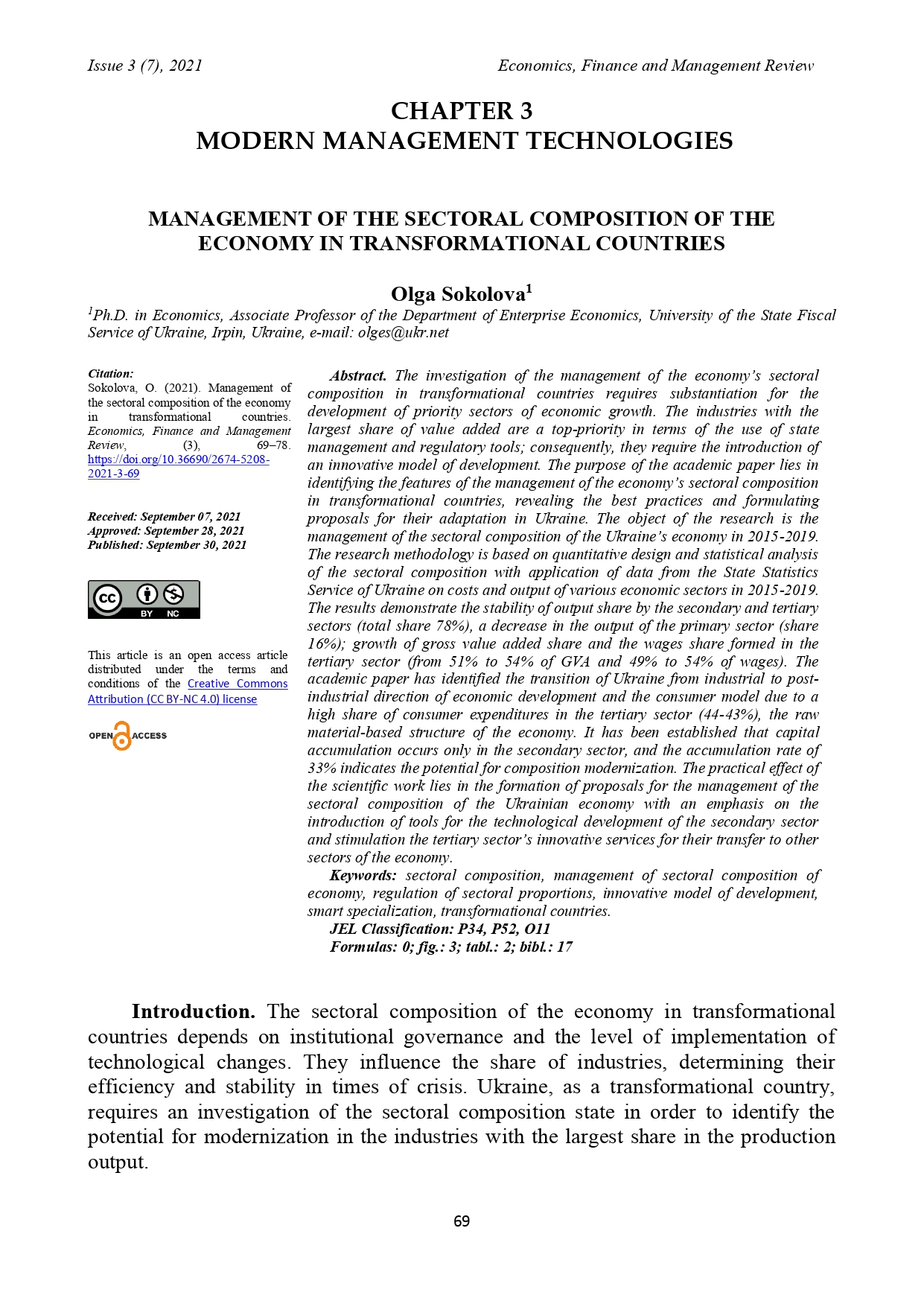MANAGEMENT OF THE SECTORAL COMPOSITION OF THE ECONOMY IN TRANSFORMATIONAL COUNTRIES
DOI:
https://doi.org/10.36690/2674-5208-2021-3-69Keywords:
sectoral composition, management of sectoral composition of economy, regulation of sectoral proportions, innovative model of development, smart specialization, transformational countriesAbstract
The investigation of the management of the economy’s sectoral composition in transformational countries requires substantiation for the development of priority sectors of economic growth. The industries with the largest share of value added are a top-priority in terms of the use of state management and regulatory tools; consequently, they require the introduction of an innovative model of development. The purpose of the academic paper lies in identifying the features of the management of the economy’s sectoral composition in transformational countries, revealing the best practices and formulating proposals for their adaptation in Ukraine. The object of the research is the management of the sectoral composition of the Ukraine’s economy in 2015-2019. The research methodology is based on quantitative design and statistical analysis of the sectoral composition with application of data from the State Statistics Service of Ukraine on costs and output of various economic sectors in 2015-2019. The results demonstrate the stability of output share by the secondary and tertiary sectors (total share 78%), a decrease in the output of the primary sector (share 16%); growth of gross value added share and the wages share formed in the tertiary sector (from 51% to 54% of GVA and 49% to 54% of wages). The academic paper has identified the transition of Ukraine from industrial to post-industrial direction of economic development and the consumer model due to a high share of consumer expenditures in the tertiary sector (44-43%), the raw material-based structure of the economy. It has been established that capital accumulation occurs only in the secondary sector, and the accumulation rate of 33% indicates the potential for composition modernization. The practical effect of the scientific work lies in the formation of proposals for the management of the sectoral composition of the Ukrainian economy with an emphasis on the introduction of tools for the technological development of the secondary sector and stimulation the tertiary sector’s innovative services for their transfer to other sectors of the economy.
Downloads
References
Biscione, A., Caruso, R., & de Felice, A. (2021). Environmental innovation in European transition countries. Applied Economics, 53(5), 521-535.
Bogdanov, N., Rodić, V., & Vittuari, M. (2017). Structural change and transition in the agricultural sector: Experience of Serbia. Communist and Post-Communist Studies, 50(4), 319-330.
Dauth, W., & Suedekum, J. (2016). Globalization and local profiles of economic growth and industrial change. Journal of Economic Geography, 16(5), 1007-1034.
Dergalyuk, B. (2019). Structural elements of the economy and their proportions. Entrepreneurship and innovation, (7), 52-55. https://doi.org/10.37320/2415-3583/7.8
Draskovic, V., Popov, E., & Peleckis, K. K. (2017). Modelling of Institutional Changes in Transition Countries-the Gap Between the Theory and Practice. Montenegrin Journal of Economics, 1(13), 121-140.
Kleibrink, A., Larédo, P., & Philipp, S. (2017). Promoting innovation in transition countries. A trajectory for smart specialization.
Martin, R., Sunley, P., Gardiner, B., & Tyler, P. (2016). How regions react to recessions: Resilience and the role of economic structure. Regional Studies, 50(4), 561-585.
North, D. C. (2018). Institutional change: a framework of analysis. In Social Rules (pp. 189-201). Routledge.
Olczyk, M., & Kordalska, A. (2018). Growth and structural changes in transition countries: the chicken or the egg?. Journal of Business Economics and Management, 19(3), 544-565.
Quatraro, F. (2016). Co-evolutionary patterns in regional knowledge bases and economic structure: evidence from European Regions. Regional Studies, 50(3), 513-539.
State Statistic service of Ukraine (2021a). Changing the deflator of gross domestic product. Retrieved from http://www.ukrstat.gov.ua/operativ/operativ2007/vvp/def_vvp/arh_def_u.html
State Statistic service of Ukraine (2021b). Cost-output table (at basic prices). Retrieved from http://www.ukrstat.gov.ua
Trubnik, T. (2012). Methodological aspects of statistical analysis of the development of the sectoral structure of the national economy. Economic analysis, (10 (2)), 76-82.
Trubnik, T. E. (2014). Statistical assessment of disparities in the sectoral structure of the national economy. Bulletin of Kyiv National University named after Taras Shevchenko. Series: Economics, (157).
Veugelers, R., & Schweiger, H. (2016). Innovation policies in transition countries: one size fits all?. Economic Change and Restructuring, 49(2), 241-267. https://doi.org/10.1007/s10644-015-9167-5
Zhao, J., & Tang, J. (2018). Industrial structure change and economic growth: A China-Russia comparison. China Economic Review, 47, 219-233. https://doi.org/10.1016/j.chieco.2017.08.008
United Nations (n. d.). Structural transformation in developing countries: Cross regional analysis. Retrieved from https://unhabitat.org/sites/default/files/download-manager-files/Structural%20Transformation%20in%20Developing%20Countries-FINAL.pdf

Downloads
Published
How to Cite
Issue
Section
License

This work is licensed under a Creative Commons Attribution-NonCommercial 4.0 International License.








